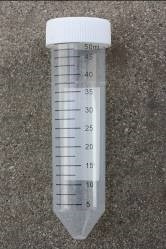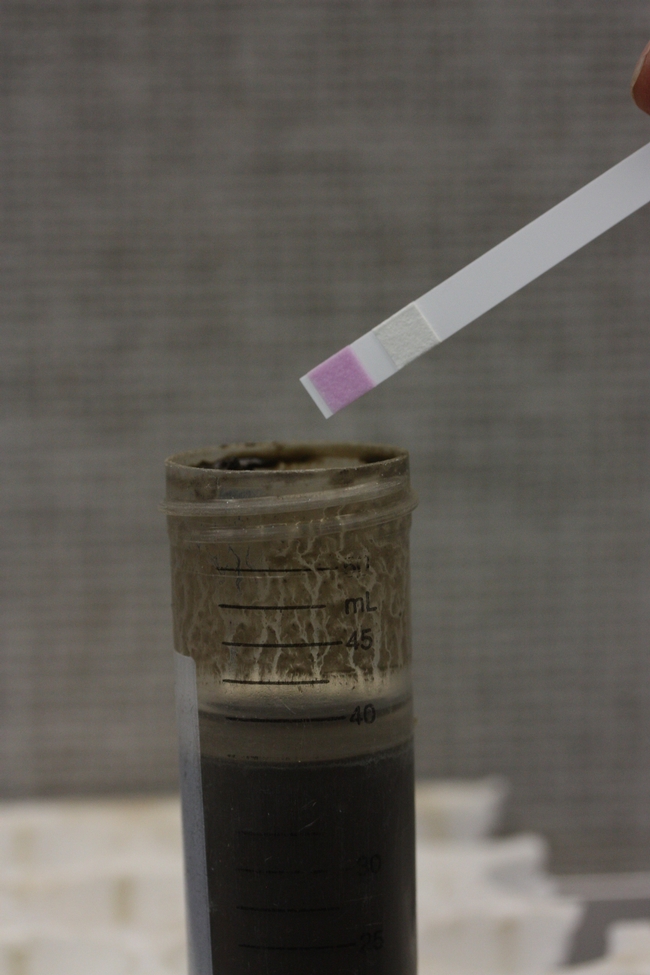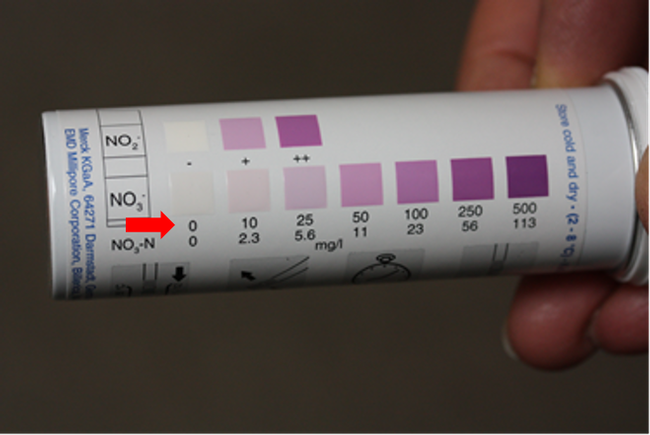Background
Testing the soil for nitrate is critical for managing fertilizer in crop production. Soil nitrate levels are continually in flux due to inputs of nitrate from fertilizer, mineralization of soil organic matter and crop residues, and irrigation water, as well as from losses of soil nitrate from leaching, crop uptake and denitrification. As a result, we advise to measure soil nitrate as close to a fertilization event as possible to make your decision based on current soil nitrate levels. Soil samples can also be sent to a laboratory for nitrate analysis, but there can be a lag in getting the results back which can reduce the usefulness of the analysis for making fertilizer decisions.
The soil nitrate quick test has the advantage over laboratory tests of analyzing soil nitrate in a timely fashion so that accurate fertilizer application decisions can be made. The soil nitrate quick test is often used just before a fertilizer application. If soil nitrate values are high enough, it is possible to reduce the fertilizer rate or even skip the fertilizer application without jeopardizing crop yield because the existing nitrate in the soil supplies the plant with nitrogen in the same way as applied fertilizer.
Procedure
Soil cores are taken to a 12-inch depth for lettuce and spinach; however, for deeper rooted crops such as broccoli and cauliflower, soil cores of the second foot of soil during the last half of the crop cycle provide additional information on residual soil nitrate available for crop growth. Scrape away the soil from the top 2 inches of soil as it may be high in nitrate (due to upward movement of salts), but too dry for the plants to access. We have found that on some soil types (e.g. clays, silty clays) it is important to angle the soil probe in the direction of the fertilizer bead or drip tape (in fertigated situations) (See Figures 1 & 2). The reason for this is that in these soils, the fertilizer sometimes does not move far with the irrigation water and by angling the probe, you collect a more representative sample. As a matter of habit, we angle the probe on all soil types to keep our sampling method uniform.
Sample the field in a pattern that goes from one end of the field to the other, both sides of the field and through the middle – generally an “X” or “N” shaped pattern is fine. For a representative sample, it is important to collect enough samples, generally, 15 to 20 soil cores.
After collection, the sample needs to be thoroughly homogenized. Sandy soils are easily homogenized, but sticky clays or even wet loams are too gummy to mix. In these situations, we do the “pinch” method by laying out the soil cores and pinching off small, uniform amounts of soil from up and down each core. We then mix the pinches and use them for placing in the calcium chloride solution (see below). The strips are read with colorimetric test strips (see photo). The cheapest are the MQuant nitrate test strips described below. They can also be read with the Reflectoquant reader which provides a more accurate reading of the color development using Reflectoquant test strips.


Figures 1 & 2. Insert the probe in the seedline, but angle it to go beneath the bead of fertilizer or beneath the drip tape.
Procedure for conducting the nitrate quick test:
Equipment Needed
- MQuant 1.10020.0001 nitrate and nitrite test strips (0 to 500 ppm nitrate). They are available from MilliporeSigma or Amazon and contain 100 strips. They should be stored in a refrigerator when not being used for field testing. Also because color development may change as the strips age, it is advisable to store solutions of known nitrate concentration in a refrigerator to test if the strips are still accurate.
- 50 ml polyethylene centrifuge tubes (Figure 3) and a rack to hold sample tubes. These can be ordered from scientific supply companies, but they want to sell large batches that cost more. Amazon will sell smaller batches that are cheaper.
- Calcium chloride dihydrate. Can be ordered from scientific supply companies, but aquarium or food grade (e.g. canning supply companies or bulkfoods.com) calcium chloride is also fine for conducting the test.
- 1 gallon of distilled water
- Add 5.6 grams of calcium chloride to 1 gallon of distilled water to make up the 0.01 M calcium chloride solution
Note: Nitrate test strips should be stored in a refrigerator when not being used for field testing. Also because color development may change as the strips age, it is advisable to store solutions of known nitrate concentration in a refrigerator to test if the strips are still accurate. Using water samples from several wells with different concentrations of nitrate could be used to test if the strips continue to provide consistent readings.
Procedure
- Collect a composite soil sample as described above.
- Fill a volumetrically marked tube or cylinder to the 30 ml level with 0.01 M Calcium Chloride (CaC12) solution.
- Add soil to the tube until the liquid level rises to 40 ml; cap tightly and shake vigorously until soil is thoroughly dispersed. Let sit until soil particles settle out.
- When solution is reasonable clear, dip the nitrate test strip into the solution, shake off excess solution, and wait 60 seconds. Compare color with the color chart provided (Figure 4)
- To minimize variability inherent in soil sampling, run duplicate samples for each field soil evaluated.
Figures 3. An empty polyethylene centrifuge tube. Figure 4. Dip the test strip in the clear supernatant and allow it to develop color for 1 minute
Figure 5. Use the scale indicated by red arrow for calculating soil nitrate concentration for mQuant test strips.
Interpretation
The MQuant test strips are calibrated both in parts per million ppm NO3 and ppm NO3-N. Reading the ppm NO3 value (Figure 5), use the table and equation below to convert the reading to ppm NO3-N in dry soil:
Strip reading (ppm NO3) ÷ correction factor = ppm NO3-N in dry soil
|
Correction Factor |
||
|
Soil Texture |
Moist Soil |
Dry Soil |
|
Sand |
2.3 |
2.6 |
|
Loam |
2.0 |
2.4 |
|
Clay |
1.7 |
2.2 |
For instance, a reading from the test strips of 25 ppm NO3 from a moist loam would have 12.5 ppm NO3-N in the soil (25 ÷ 2 = 12.5). The ppm NO3-N values can be converted to pounds of nitrogen per acre in the top foot of soil by multiplying by 3.7, and in this example, that would equal 46 pounds of nitrogen per acre.
In general, soils with less than 10 ppm NO3-N are considered low for fast growing vegetable crops and soils with levels above 20 ppm NO3-N may have enough available N to supply crop needs for a limited period. Intermediate concentrations between 12 and 15 ppm NO3-N may warrant a half rate of fertilizer. However, it is important to get familiar with the nitrate quick test by doing small trials on your farm. As you gain more confidence in using the test to adjust fertilizer applications, you can do larger trials. Keep in mind that nitrate is very mobile, and in light textured soils, heavy irrigation/rainfall events can reduce the amount of available nitrogen in the soil. That is why it is always good to be cautious in reducing fertilizer applications based on the soil nitrate test. Feel free to contact either of us if you have any questions.
Additional information resources on soil nitrate testing and nitrate in irrigation water:
Using the Pre-Sidedressing Soil Nitrate ‘Quick Test' to Guide N Fertilizer Management
Accuracy of Test Strips for Assessing Nitrate Concentration in Soil and Water
Sampling for Soil Nitrate Determination
RQflex reader can improve the accuracy of nitrate test strips
Presidedress nitrate quick test reduces nitrate leaching hazard in lettuce
Estimating N contribution from irrigation water containing nitrate


